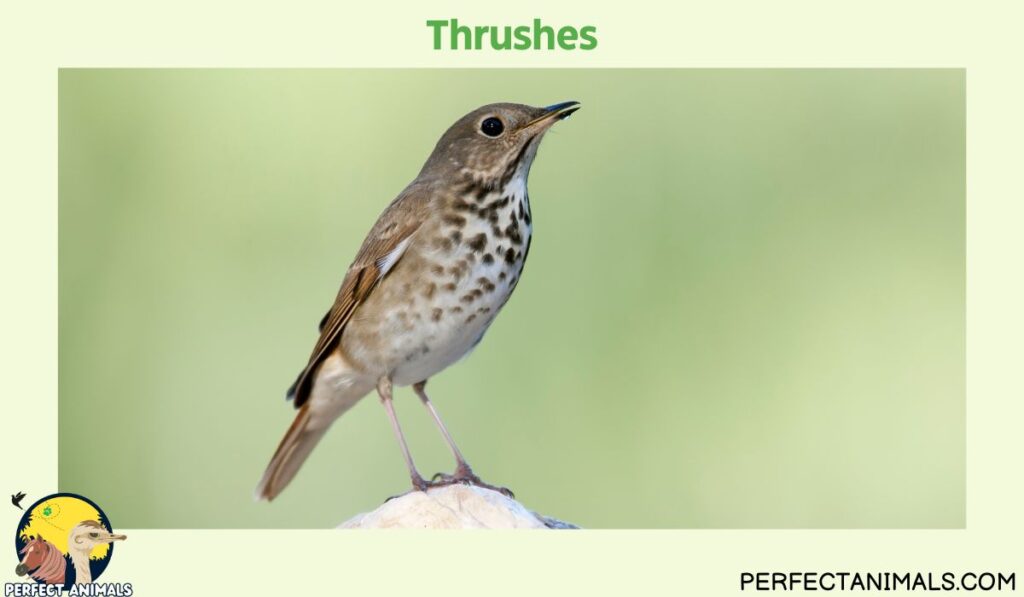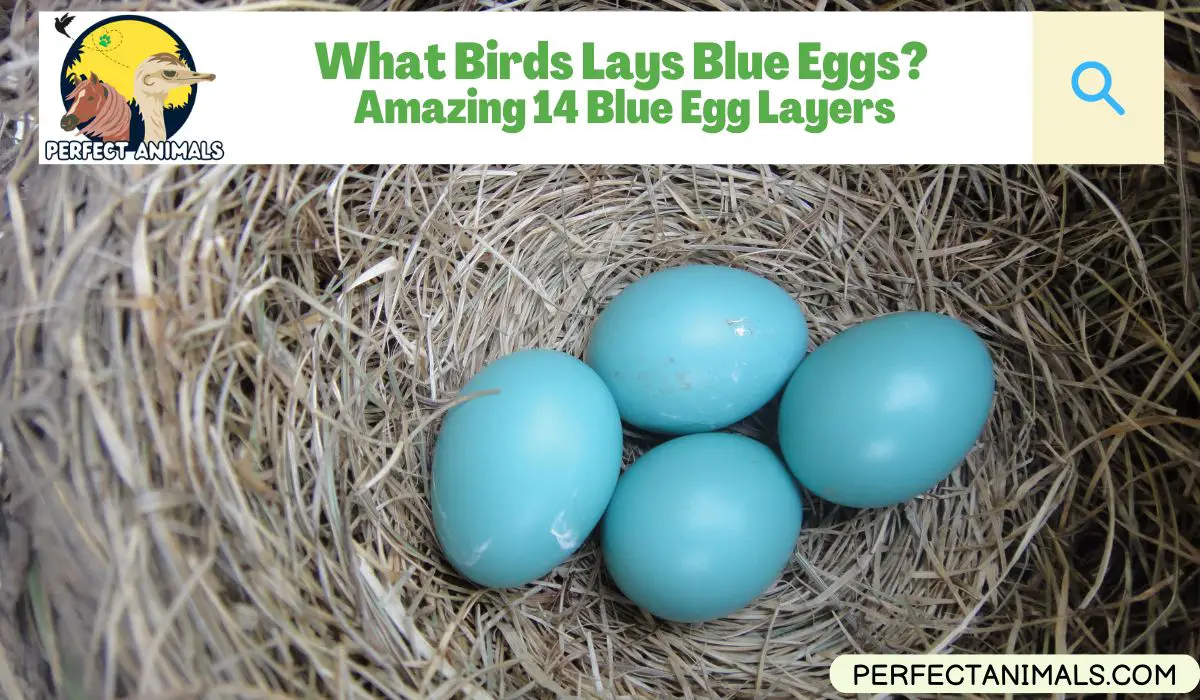The sight of a bright blue egg in a nest often takes people by surprise.
As common as brown or white eggs are in nature, coming across a vivid blue one stands out as unusual.
But there are actually a number of bird species that lay blue or bluish-colored eggs. The shade can range from a pale robin’s egg blue to deeper aqua tones.
While the blue egg coloration may seem like a marvel of nature, there is a scientific reason behind it.
The blue and green shades happen due to pigments the female birds deposit as the eggs develop.
So which avian creatures can lay azure-shelled eggs? There are well over a dozen species spanning backyards, wetlands, and rainforests around the world.
From familiar names to exotic tropical birds, read on to discover the full list of birds that lay blue eggs.
Understanding the variety of blue egg layers in the natural world gives new insight into bird reproduction and evolutionary biology.
What Birds Lays Blue Eggs?
Blue Jays
The Blue Jay is a stunning songbird known for its bright blue feathering.
What’s a little-known fact is that they also lay light blue eggs, almost akin to a pale robin’s egg color.
The blue jay’s blue eggs help camouflage the eggs in the tops of trees where their nests are often carefully built.

With streaks of olive and brown in the blue, the shells blend right into the natural hues of twigs and branches.
The female blue jay lays between 3-6 light blue eggs per clutch.
Both parents take turns incubating the eggs for around 17 days before they hatch.
Once the chicks emerge, they are nursed by the mother bird for up to two weeks until they fledge the nest.
In terms of evolution, the blue jay’s blue eggs preceded their vibrant blue feathers, which developed after their eggs as a protective mimicry.
Their blue eggs ensure the next generation of blue jays is safely concealed high up in the canopy when they are at their most vulnerable stage.
Related Article – Blue Jay Eggs
Bluebirds
Brilliantly plumed Bluebirds are famous for more than their vivid cerulean feathers – they also lay sky-tinted eggs.
The male Eastern Bluebird’s sapphire coloring provided the inspiration for their eggs.
The shell itself can range from pale blue with white streaks to a bolder robin egg shade.

In clutch sizes of around 5 eggs, the blue eggs blend into the nest box surroundings, hiding them from predators like snakes and raccoons.
The green-blue eggs turn even more greenish before hatching after 13-14 incubation days.
Then the hatchlings emerge looking like mini replicas of their parents with fuzzy feathers.
The North American Bluebird species including Eastern, Western, and Mountain Bluebirds predominantly choose tree hollows or man-made nesting boxes across open grasslands, pastures, and yards.
Their bright blue eggs glow like beacons signaling the continuity of these beloved songbirds.
American Robins
With their red-orange chests and cheery spring song-filling backyards across North America, the American Robin is a classic sign of the season.
This familiar bird also lays a distinctive light blue egg easily spotted in their large cup-shaped nests.
The female robin deposits light blue eggs that mimic the sky to camouflage them in tree branches and rain gutters.

In clutches of 3-5 eggs over a week, the blue eggs show little variation in color so they blend amidst the twigs and grass of their nests.
The blue egg color comes from biliverdin, a natural pigment that also tints robin’s eggs green.
Sitting on their eggs for two weeks, the eggs turn a paler milky blue color right before they hatch.
Then fuzzy-headed chicks emerge and are fed by both parents immediately.
Within two weeks, the chicks leave the nest becoming juvenile robins – ensuring this blue egg-laying songbird continues flourishing.
Related Article – 10 Amazing Birds With Long Legs
Starlings
European Starlings may be an invasive species in North America but their incredible iridescent feathers and spotted blue eggs still fascinate.
Non-native Starlings often usurp the nests of native cavity nesters but then display stunning mothering behaviors.
Females lay 5-7 eggs in a clutch, with each egg a light blue or bluish-green base dotted with tiny brown spots.

Against the dark nesting cavity or nest box interior, the pale eggs serve as camouflage from predators.
Both parents share equally in sitting on the eggs for 10-13 days until they hatch.
Once the chicks arrive, the nest fills with gaping yellow beaks needing constant feeding by the dedicated parents.
The bright blue eggs hint at the beautiful iridescent feathers the juvenile starlings will molt into.
Within 3 weeks, they emerge from the nest fully grown to form massive flocks around fields, trees, and buildings through the seasons.
Dunnocks
The Dunnock is a small brown European songbird that blends into shrubbery across yards and parks.
But a closer look reveals their hidden secret – eggs in shades of blue carefully tucked into nests on the ground.
From Robin’s egg blue to almost turquoise tones, Dunnock eggs are truly colorful.

The brighter blue eggs contrast against the duller female feathers as she sits tight to her brood.
Made up of 5-6 eggs per breeding cycle, Dunnock clutches present a mosaic of blue shells to confuse predators.
Both sexes play a role, with males incubating the eggs during the day and females at night for 12-14 days before hatching.
Once the chicks emerge, they are fed insects and seeds by both parents constantly.
Soon the juvenile dunnocks will take on their understated brown plumage and continue propagating the next generation of sky-tinted blue eggs hidden in European shrubbery and gardens.
You May Also Like – Why Do Owls Hoot?
Great Tinamous
The Great Tinamou is a large ground-dwelling bird residing in Central and South America in places like Panama and Ecuador.
Related to rheas and ostriches, they blend into the forest understory and grasslands quite easily.
That is until a Great Tinamou lays its eggs – then vivid colors abound. Like smaller tinamous, the Great Tinamou lays rich indigo eggs with white and black spots speckling them.

Clutches contain 5-10 eggs which allow tinamous to recover quickly if a nest fails.
The male takes up brooding duty during the day while the female incubates them at night for around 16-20 days.
This coordination ensures the vivid blue eggs have round-the-clock care to survive.
Once hatched, the brown-striped chicks leave the nest within a day proving very self-sufficient despite their bright egg beginnings.
Within a year these precocial birds reach sexual maturity and take their turn incubating eggs in shades of azure and cobalt unseen anywhere else in South America’s avian families.
Common Mynas
The Common Myna may be best known for its ability to mimic speech but it has another special skill – laying eggs in striking hues of blue.
Native to Asia, these accomplished avian imports now thrive from East Africa to New Zealand.
Females choose nooks in buildings, nest boxes, or tree hollows to lay a clutch of 4-6 eggs with bright blue shells.

Sometimes bedecked in reddish-brown spots, Common Myna eggs range from a robin’s egg color to almost turquoise.
Against the dark hollow backgrounds, the vivid eggs stand out markedly to parental eyes but stay camouflaged from predators.
Taking up equal parenting duties, myna pairs trade-off incubating for around 18 days before the hatchlings break through.
Once born, the wide-mouthed chicks create a noisy nest begging to be fed frequently by both parents.
Soon enough, those sky-blue eggs give rise to juvenile mynas ready to start learning speech and their parent’s mischievous behaviors thanks to successful hatching.
Related Article – 12 Clever Birds That Eat Spiders
Gray Catbirds
As a species migrating long distances, Gray Catbirds excel at producing numerous clutches in a short breeding season across Eastern North America.
Their key is laying eggs in varying shades of blue from April to August each year.
Hidden within dense shrubs sheltering their nests, Gray Catbird eggs range from a robin’s egg color to a bolder denim blue hue.

Clutch sizes average around 3-5 eggs which take a little over two weeks to incubate before the nest is filled with gaping mouths to feed.
The fathers dedicate themselves completely to gathering insects and berries during this period to satisfy their endless appetites.
Meanwhile, the dull gray mothers remain steadfast in their blue broods until the fuzzy hatchlings emerge needing food constantly.
Soon these adept mimics grow quickly to leave the nest in just 8-9 days.
The pairs can raise to 3-4 broods thanks to their effective strategy of reproducing waves of blue-egg layers keeping their migratory populations stable further north.
House Finches
The red-plumed males of House Finch pairs work hard to supply food while their mates lay vivid blue eggs.
One of the most brightly colored eggs laid by any songbird, House Finch eggs range from a robin’s egg shade to richer sky-blue tones with darker markings.
The females pluck fibers and feathers to line the nests tucked away in tree hollows across the western United States suburbia.

Laid in clutches of 4-5 per breeding cycle, the bright blue eggs take just two weeks to incubate before tiny hatchlings call to be fed.
Staying with the chicks as they grow, the mother finch gets help from her crimson male partner kept busy finding seeds and insect grub.
Soon the gape-mouthed chicks develop warm brown plumage, save for the young males who get their first scarlet feathers before fledging the nest.
Thanks to their brilliant blue eggs and superb parenting, House Finches spread successfully across America in just decades since their first release.
You May Also Like – Top 10 Birds With Long Beaks
Thrushes
As a family of birds, various thrush species around the world share the characteristic of laying blue eggs of varying shades and intensities.
From the deep indigo eggs of Chinese Blue Thrushes to the lighter sky blue eggs of American Robins, thrushes tend to select hues of blue more than other colors.
Evolutionary biologists propose their blue eggs served as a signal of genetic fitness to potential mates.

The bright color indicates the female thrush had access to plenty of calcium and resources to produce such vibrant eggshell pigments.
Male thrushes were likely selected for brighter blue eggs, leading to the dominance of blue egg layers across thrush species inhabiting Asia, Europe, Africa, and the Americas till today.
Blackbirds
Scarlet-winged male Red-winged Blackbirds may catch people’s eyes more readily, but the dull-plumaged females deserve admiration for their blue-egg-laying abilities.
Building basket-type nests in wetlands across North America, female Red-winged Blackbirds lay light blue eggs often covered in brown spotting.
The 3-5 eggs per clutch allow the female to devote enough energy and nutrients to each growing chick.

On the nest, blackbird mothers incubate while being guarded closely by their fire-bright consorts.
The eggs turn a lighter milky blue right before hatching after 11-14 days of warmth.
Once the nestlings emerge, both blackbird parents maintain a busy schedule gathering insects, seeds, and berries to satisfy their chicks’ appetites.
Thanks to the bounty of marshlands, the vivid blue eggs yield another generation of blackbirds year after year.
You May Also Like – 9 Owls of Illinois
Black Tinamous
Related to the Great Tinamou of South America, the Black Tinamou similarly lays beautiful blue eggs, unlike any other ground bird.
Found in Central America in forests and savannahs, this plump bird blends into the dark leaf litter easily.
But locating its nest reveals a clutch of 8-10 eggs covered in sky blue and indigo shells dotted with little brown specks.

These tinamous practice polygamy with males partnered with multiple females simultaneously.
So females alone must incubate the eggs for at least 16 days before they hatch.
To counter any lost effort, black tinamous lay up to 30 eggs per season ensuring reproduction success.
Once the striped chicks emerge, they can move and feed on their own soon after hatching as a protective measure.
Thanks to such resiliency, this little-known Central American bird persists due to its strategy of proliferating blue eggs across the landscape.
Snowy Egrets
Most herons and egrets lay aqua-colored eggs suited to their wetland lifestyles.
But the Snowy Egret ups the color dramatically by producing eggs richly hued blue-green like their distinctive yellow feet.
Nesting near water bodies across America, these slender white shorebirds build sturdy nests in protected thickets and brambly bushes.

Amidst the platform, the female lays 3-6 eggs per clutch that turn from green to bright blue over their incubation period.
Both male and female egrets share parenting duties, sheltering the eggs and circling the nest to divert disturbances.
Over three weeks later, the bright blue eggs like giving way to fabulously fluffy egrets whose stunning plumage only continues to intensify as they mature.
Thanks to these efforts, the parents secure the next class of elegant hunters carrying on their vibrant blue eggs for posterity.
Herons
The gangly and stealthy Herons thriving around water bodies rely on blue eggs to propagate their patient kind.
Species like the widespread Great Blue Heron lay pale blue eggs that fade to white; almost the reverse of other blue egg producers.
Choosing platforms of sticks in quiet marshes and swamps, female herons lay around 3-6 eggs depending on the availability of food sources that year.

Both decidedly mute parents share sitting on the eggs until they hatch after approximately 28 days.
Once the hatchlings emerge, they grow astonishingly fast into mini replicas of their adult selves, ready to stalk and strike fish and frogs after fleeing the nest.
Thanks to the protective coloring on their bundled nests and their reptilian approach to child-rearing, herons persist on every continent continuing their ancient lineage – one blue egg clutches at a time.
Final Thoughts
When we think of blue eggs, chicken breeds like Araucanas or Easter Eggers probably first come to mind.
However, as we’ve seen, there are well over a dozen wild bird species around the world that naturally produce blue and blue-green eggs too.
From jays and thrushes to exotic tinamous, many birds have evolved the ability to lay vivid blue eggs for camouflage, signaling fitness, or through sheer chance.
The range of shades from robin’s egg blue to deep turquoise reflects the diversity of habitats and nesting strategies different avian families have developed over millennia.
Whether in marshy reeds, tropical rainforest floors, or suburbia nest boxes, the blue eggs blend into their surroundings, avoiding predation during the crucial incubation and nestling growth phases.
So next time you come across a bright blue egg, think twice before assuming it belongs to the Easter Bunny!
More likely it signals the renewal of one of these marvelous blue egg layers nesting in your backyard, city park, or local wetland preserving their lineage.
Their ability to create blue pigments through biological processes and ensure successful breeding continue to make blue eggs truly wondrous natural events, no matter how small the bird is.
Resources – (for further reading)
Wikipedia – Blue Jay | Bluebird | American robin | Starling
Britannica – Great tinamou | Dunnock ,Habitat, Song, Breeding
eBird – Black Tinamou | House Finch Haemorhous mexicanus

Lisa W. is a devoted bird lover, especially fond of her pet macaw, Sakkari. With a multitude of pet birds, she’s well-versed in bird care and behavior. Lisa has actively contributed to bird conservation and habitat restoration through her published research papers. She passionately shares her insights by crafting engaging articles for our site.

